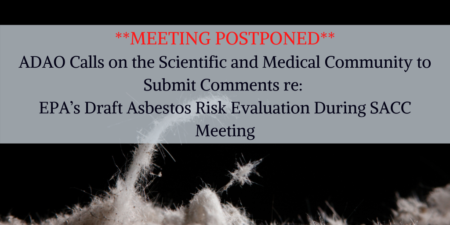Posted on April 14, 2020
Register to attend (non-comment) the April 27-30 SACC Draft Risk Evaluation Review Meeting
Submit a written comment to the Draft TSCA Asbestos Risk Evaluation
4/20/20 UPDATE: MEETING POSTPONED DUE TO COVID-19. WE WILL NOTIFY WHEN NEW MEETING DATE IS RELEASED
On March 30th, the Environmental Protection Agency (EPA) released its Draft Asbestos Risk Evaluation under the Toxic Substances Control Act (TSCA). The evaluation will be reviewed on April 27-31 by EPA’s independent Science Advisory Committee on Chemicals (SACC).
The day the evaluation was released, ADAO sent EPA Administrator Wheeler a letter urging him to postpone the SACC meeting because health professionals and scientists are consumed by the demands of COVID-19 and would not be able to fully respond to the risk evaluation. The letter was ignored.
The EPA risk evaluation concludes that nearly all current risks of asbestos pose unreasonable risks to consumers and workers — findings that we strongly agree with. However, we believe the evaluation excludes numerous exposure pathways and asbestos-related diseases and greatly understates the risks presented by asbestos. Unfortunately, EPA has once again failed to protect the health of the American people, and is using the global pandemic to fast-track its draft evaluation without careful review by scientists and the public.
There has been a recent increase in imports of asbestos, a clear sign that the chemical industry does not intend to lessen or stop the use of this lethal carcinogen. Data published by the U.S. International Trade Commission revealed 334,000 pounds of raw asbestos (172 metric tons) imported in 2019. Asbestos kills nearly 40,000 Americans each year, yet EPA is allowing imports and use to continue.
The April 27-30, 2020, SACC meeting to review the draft evaluation will be via telephone and webcast. The SACC will review written comments submitted by April 22 (and perhaps later). Oral comments of 5 minutes in duration will be allowed on the afternoon of April 27. Registration is required by those who want to make oral comments or listen to the meeting. The SACC members are very interested in input and will consider it carefully when they write their report to EPA.
ADAO is deeply concerned with the current risk evaluation and encourages members of the scientific and medical community and those involved in occupational safety and health to register and submit an oral comment, written comment, or virtually attend the discussions. The time to take action is now, and we must come together as a community to oppose this flawed risk evaluation and emphasize the serious harm that asbestos causes..
Through the oral and written comments submitted by ADAO and colleagues, we intend to support EPA’s unreasonable risk determinations and defend them from industry challenges while at the same time emphasizing that the EPA evaluation is not complete and fully protective in several respects. Although there are many flaws in the Draft Risk Evaluation, we plan to focus one the below six points:
-
- The draft evaluation does not address the risks of legacy asbestos products contained in millions of buildings across the US, despite a ruling from the Ninth Circuit Court of Appeals last year that EPA is obligated to evaluate these risks.
- The evaluation only examines one type of asbestos fiber — chrysotile — while there are six recognized commercial asbestos fibers.
- EPA only looks at the risks of lung cancer and mesothelioma, and does not consider other types of cancer (ovarian and laryngeal), or serious non-cancer diseases (asbestosis) that are known to be caused by asbestos
- EPA has ignored the documented presence of asbestos contamination in talc-based crayons and other common consumer products to which infants and children are exposed.
- EPA has excluded all environmental pathways of exposure, including air emissions, contaminated waste, and drinking water contamination, further underestimating risk.
- EPA has excluded Libby Amphibole asbestos which is contained in attic insulation found in 15 – 30 million homes.
We look forward to the collection of comments that will be submitted by our community. The time is NOW to ban asbestos and save lives.
ADAO stands ready to provide assistance and support to those who seek to offer their views and concerns to the EPA SACC. Do not hesitate to reach out to us.
In Unity,
Linda Reinstein
Social Networks
